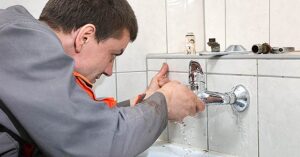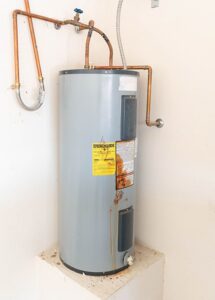When people think of noble professions, medical professionals, first responders, teachers, and mothers come to mind. But plumbing is also a crucial trade that protects our health and well-being. Contact Plumbers Topeka now!
Most people associate plumbers with the grueling work of showing up at a home or business after hours when a pipe burst or sewage backs up. But they also play a significant role in new construction, consulting blueprints, and installing piping systems.

Plumbing systems are vital to the health and well-being of individuals, providing clean water and effective waste disposal. Plumbers install and repair these systems in residential and commercial buildings. Their responsibilities include:
- Laying pipes.
- Installing toilets and sinks.
- Connecting appliances like washing machines and dishwashers.
- Ensuring that all components work properly.
Plumbers must also be familiar with building codes and regulations. They use specialized tools to identify and resolve leaks, clogs, and broken components.
Many plumbers train through an apprenticeship, combining classroom instruction with paid on-the-job training. These programs last four to five years and cover local plumbing codes, blueprint reading, and safety practices. After completing an apprenticeship, plumbers must pass an exam and earn a license to work independently.
Plumbers often work with customers to understand their needs and provide advice on plumbing solutions. They must have excellent customer service skills to communicate effectively and explain complex plumbing problems in layperson’s terms. In addition, they must be able to provide accurate estimates for plumbing projects.
Plumbers must follow strict safety guidelines since plumbing involves working with dangerous materials. For example, they must wear protective equipment when handling chemicals or entering sewage systems. They also need physical stamina to perform tasks like bending and kneeling for extended periods and using heavy tools. Plumbers must also be comfortable working in tight spaces and around electrical wiring. Finally, plumbers must be able to identify and repair issues promptly to prevent further damage and expensive repairs. This is why choosing a plumber with extensive experience and training is important. The right plumber can save you time and money in the long run.
Plumbers must have excellent analytical skills to troubleshoot plumbing issues and determine the best course of action. They must have the ability to weigh options and choose solutions that will be cost-effective and safe for their clients. They must also be comfortable communicating with customers and providing estimates for their work. This requires excellent customer service skills, including listening to their client’s concerns and explaining complex plumbing concepts in layperson’s terms.
One of the most common plumbing issues is clogged drains and drain lines. A professional plumber can use specialized equipment to clear clogged pipes without damaging the surrounding pipe walls. They can also repair or replace damaged parts to ensure the pipe is completely functional.
Another common issue is water leaks. If left untreated, plumbing leaks can cause serious damage to the home and lead to high utility bills. Plumbers can fix leaky faucets, showers, bathtubs, and toilets and inspect the entire plumbing system to identify any issues that may need attention.
Plumbers often deal with dangerous substances, such as sewage, so they must be able to handle these materials safely and efficiently. This involves using specialized tools and procedures like hydrojetting to remove clogs and clean drain lines. They can also use a video camera to inspect sewer lines for problems, such as breaks and corrosion. In this case, they may need to excavate and replace the line. When a sewer line clog occurs, it is important to contact a plumber immediately, as these clogs can be difficult and expensive to resolve. A homeowner can risk injury or property damage if they try to tackle the problem themselves.
Like any other machine, the plumbing system in homes and businesses requires regular maintenance to ensure it functions properly. A professional plumber can inspect the pipes, fixtures, and appliances to detect any issues before they become major problems requiring costly repairs or replacements. Plumbing services can include everything from testing water pressure to identifying leaks and clogs.
Keeping plumbing systems functioning optimally helps reduce water and energy costs. It also helps mitigate environmental pollution caused by wastewater and keeps water healthy for human consumption. Plumbing maintenance includes testing the water temperature to prevent scalding and ensuring the water pressure is low enough to prevent pipe damage.
Plumbers may also be responsible for laying new pipes and installing water heaters and other appliances. They may work with builders and architects to plan out the installation of plumbing infrastructure in new construction projects or renovations. These tasks require attention to detail and a strong understanding of building codes and regulations.
Plumbing technicians must be able to solve complex problems quickly and accurately. They often use specialized equipment such as video cameras and pressure gauges to inspect pipes and troubleshoot issues. This requires critical thinking skills to identify the problem’s source and find effective and cost-efficient solutions.
Since plumbers frequently interact with customers, they must be friendly and courteous. They need to be able to listen carefully to their customer’s concerns and explain technical issues in simple terms. They must also be able to provide accurate estimates for their services. Finally, plumbing is a physically demanding job that involves long periods of standing and lifting heavy equipment.
One of the most valuable parts of a plumber’s job is working with other professionals on building construction projects. Architects are responsible for creating designs that catch the eye, while engineers ensure those designs meet everyday life’s demands. This collaboration is essential for ensuring that the final building reflects the original vision while being safe and secure. It is also helpful for preventing costly errors that can arise during construction. For example, if an architect changes a design without consulting an engineer, the structural integrity of the entire building may be at risk.
The construction industry contributes to global carbon emissions and waste, so it’s vital for building professionals to develop eco-friendly practices. These include using renewable materials, reducing energy consumption, and practicing environmental efficiency. The benefits of eco-friendly construction are many and varied.
Besides lowering a company’s carbon footprint, eco-friendly practices can boost workers’ health. For instance, some eco-friendly construction materials are low in volatile organic compounds, enhancing indoor air quality. Moreover, rainwater harvesting and water-efficient systems can reduce a building’s water use.
Other sustainable construction practices include minimizing material waste and ensuring safe disposal. Workers who work on environmentally friendly buildings feel more energized and focused, leading to better productivity. Green buildings promote a healthy working environment, with good ventilation, clean outdoor views, and plenty of natural light.
While construction companies can implement these sustainable practices, individual builders and homeowners can also do their part to help the environment. Small changes, such as using organic paints and recycled lumber, can make a difference. Furthermore, installing water-saving fixtures reduces a household’s utility bills.
Developing eco-friendly construction practices may take time, but it has long-term benefits. The EPA notes that reducing greenhouse gas emissions decreases a business’s operational costs and improves the health of its employees, customers, and suppliers.
Achieving sustainability in the construction industry starts with reforming current industry standards. This process can involve many tasks, including modifying materials and equipment, increasing worker safety, improving efficiency, and changing building procedures. The result is an environment that preserves the world’s resources and prevents pollution, climate change, and environmental degradation. It also reduces risks associated with health problems, such as lung damage and asthma attacks.

